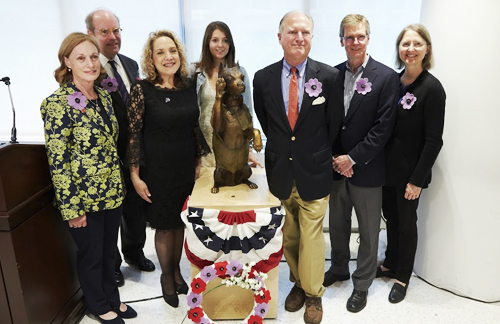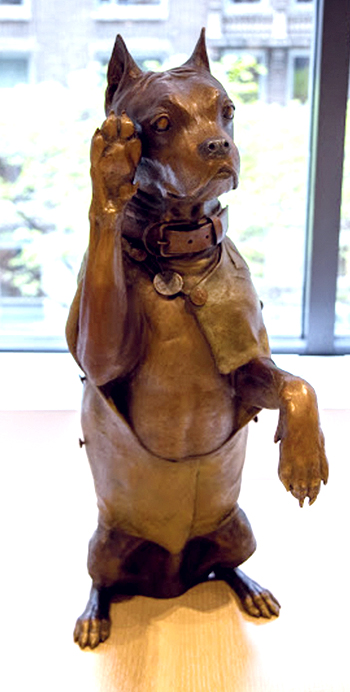Huntington Sculptor Pays Tribute To War Dogs
/Huntington artist Susan Bahary’s sculpture “Stubby Salutes” is permanently installed at the American Kennel Club’s museum in New York City. At the installation, from left, are: WWI Centennial Commission representative Dr. Libby O’Connell; American Kennel Club executive director Alan Fausel; Bahary; and members of the Sgt. Stubby’s “Conroy” family: Kaley Thornton, Curt Deane, Michael O’Brien, and Alexandra Deane Thornton surround teh sculpture.
By Sophia Ricco
sricco@longislandergroup.com
A Huntington sculptor’s statue memorializing the service of America’s first war dog has found a home.
Sgt. Stubby, a bull terrier who served as the official mascot of the 102nd Infantry Regiment during World War I, became legend for his combat exploits overseas during World War I. Sculptor Susan Bahary of Huntington memorialized Sgt. Stubby in a bronze sculpture which was recently installed at the American Kennel Club’s (AKC) Museum of the Dog in New York City. The recent addition joins two other Bahary sculptures, “Smokey” and “Always Faithful.” Smokey depicts a four-pound Yorkshire terrier who helped soldiers carry a communication cable under an airstrip through a drain pipe safeguarding 40 U.S. airplanes. “Always Faithful” is a sculpture of a doberman that sits atop a U.S. Marines Corps monument dedicated to the 25 war dogs killed in combat during World War II.
Another Bahary sculpture, “Always Faithful” sits atop a USMC monument to service dogs killed in action.
Bahary crafted these sculptures to recognize the service of dogs who saved many lives during war.
“This honors the deeds and sacrifices of all our service animals – whether it’s guide dog, war or police – and their handlers,” Bahary said. “It raises our level of awareness and compassion of how great our animals are… that we need to take care of them.”
American Kennel Club held a ceremony on May 23 to welcome “Stubby Salutes” as a permanent installation. The group laid a commemorative wreath of red and purple poppies in remembrance of soldiers and animals who gave their lives in combat.
“He is yet another tribute to the heroic canine companions and service dogs who have stood side by side with soldiers in battle,” AKC executive director Alan Fausel said.
War dogs didn’t serve until World War II, but Stubby aided soldiers on 17 battlefields in the first world war. The story goes that his owner Robert Conroy found him as a stray on Yale University’s campus. As Conroy trained for the Army, he taught Stubby tricks and the pair became inseparable.
“When it was time to ship off to France, he smuggled his friend on the ship with a blanket,” Bahary said. “When the commanding officer discovered him on the ship and asked what he was doing there, Conroy prompted [Stubby] to do ‘his salute trick.’ He got up on his haunches and gave the salute. That’s what saved him.”
Bahary’s scupture “Stubby Salutes” captures the moment when Sgt. Stubby charmed his way on board an Army transport ship by saluting.
Bahary chose to honor this moment, sculpting Stubby in his posture of salute.
The sculptor thought his valuable service in World War I made him an “iconic” dog. More than a mascot, the dog delivered messages in combat. He went into the “no man’s land” between the German and Allies’ trenches. He recognized Allied soldiers’ uniforms, and stayed with injured soldiers until help arrived. He even warned the troops about incoming artillery and attack by lethal gas.
“He could detect the smell of mustard gas being sent over,” Bahary said. “This allowed his fellow two-legged soldiers time to put on their gas masks. Thus he did save lives.”
Despite being wounded in France by shrapnel and mustard gas, Stubby continued to serve. After the liberation of one French town, the women of Chateau-Thierry made Stubby a jacket, bearing his name, the word infantry, and the Yankee insignia and flags of the Allies. Bahary’s sculpture depicts the dog proudly wearing the jacket, his arm raised in salute.
On his return to America, Stubby was given a hero’s welcome, leading parades and meeting three presidents.
The legendary Sgt. Stubby proudly wears his medals on a coat sewed for him by the women of a grateful French village.
“Although he wasn’t actually made a sergeant, he was so loved by many of the soldiers that they often gave him their medals and he wore them on his jacket,” Bahary said.
Stubby was awarded at least one medal on his own. “General John Pershing met him and awarded him a medal,” Bahary said.
When Stubby died in 1926, the New York Times ran a half-page obituary
Bahary was eager to immortalize Stubby in bronze and worked several months on research, mold making, bronze pouring, before applying the final patina.
Once complete, she showed the final statue to the Conroy family, who were “very pleased”.
“I think we were a good fit, because we both really care about the proper representation of Stubby,” Bahary said. “We’re coming from the same place and they trusted me.”
The original casting resides at the Trees of Honor in Conroy’s hometown of Middletown, Connecticut. Bahary created a limited number of additional castings to display at significant locations in honor of the 100th anniversary of Stubby’s return to the U.S.
“Stubby Salutes” can be viewed at the AKC Museum of the Dog, 101 Park Ave in New York City.









